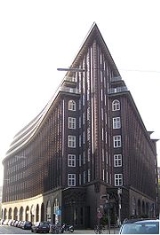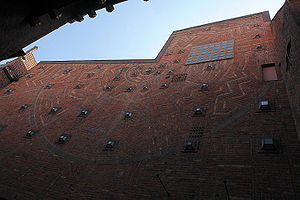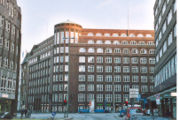
Brick Expressionism
Encyclopedia

Expressionist architecture
Expressionist architecture was an architectural movement that developed in Europe during the first decades of the 20th century in parallel with the expressionist visual and performing arts....
that uses brick
Brick
A brick is a block of ceramic material used in masonry construction, usually laid using various kinds of mortar. It has been regarded as one of the longest lasting and strongest building materials used throughout history.-History:...
s, tile
Tile
A tile is a manufactured piece of hard-wearing material such as ceramic, stone, metal, or even glass. Tiles are generally used for covering roofs, floors, walls, showers, or other objects such as tabletops...
s or clinker brick
Clinker brick
Clinker bricks are partially vitrified brick stones used in the construction of buildings.Clinkers are burnt under temperatures so high that the pores of the fuel property are closed by the beginning sinter process. Thus they are considerably denser and therefore heavier than regular bricks...
s as the main visible building material. Buildings in the style were erected mostly in the 1920s, primarily in Germany.
The style's regional centres were the larger cities of Northern Germany
Northern Germany
- Geography :The key terrain features of North Germany are the marshes along the coastline of the North Sea and Baltic Sea, and the geest and heaths inland. Also prominent are the low hills of the Baltic Uplands, the ground moraines, end moraines, sandur, glacial valleys, bogs, and Luch...
and the Ruhr area
Ruhr Area
The Ruhr, by German-speaking geographers and historians more accurately called Ruhr district or Ruhr region , is an urban area in North Rhine-Westphalia, Germany. With 4435 km² and a population of some 5.2 million , it is the largest urban agglomeration in Germany...
, but the Amsterdam School
Amsterdam School
The Amsterdam School is a style of architecture that arose from 1910 through about 1930 in The Netherlands...
belongs to the same movement. The style also had some impact outside the areas mentioned.
Style


New Objectivity (architecture)
The New Objectivity is a name often given to the Modern architecture that emerged in Europe, primarily German-speaking Europe, in the 1920s and 30s. It is also frequently called Neues Bauen...
of Bauhaus architecture. But whereas the Bauhaus architects argued for the removal of all decorative elements (ornaments
Ornament (architecture)
In architecture and decorative art, ornament is a decoration used to embellish parts of a building or object. Large figurative elements such as monumental sculpture and their equivalents in decorative art are excluded from the term; most ornament does not include human figures, and if present they...
), expressionist architects developed a distinctive form or ornamentation, often using rough, angular or pointy elements. They were meant to express the dynamic of the period, its intensity and tension.
The most important building materials were the eponymous bricks and clinker bricks. Hard-fired clinker was very fashionable, especially for facades. That material was especially well adapted to the difficult environmental requirements of industrial buildings, particularly in the Ruhr area. Its characteristic rough surface and rich variety of colours, from brown via red to purple, also contributed to the material's popularity.

Gelsenkirchen
Gelsenkirchen is a city in North Rhine-Westphalia, Germany. It is located in the northern part of the Ruhr area. Its population in 2006 was c. 267,000....
(1927).
The facade designs were enhanced by the use of architectural sculpture
Architectural sculpture
Architectural sculpture is the term for the use of sculpture by an architect and/or sculptor in the design of a building, bridge, mausoleum or other such project...
, made of clinker bricks or ceramic
Ceramic
A ceramic is an inorganic, nonmetallic solid prepared by the action of heat and subsequent cooling. Ceramic materials may have a crystalline or partly crystalline structure, or may be amorphous...
s. A well-known representative of this form of art was Richard Kuöhl
Richard Kuöhl
Richard Kuöhl was a German sculptor, specializing in providing architectural sculpture for the architects of the Brick Expressionism style in northern Germany in the 1920s....
. Ernst Barlach
Ernst Barlach
Ernst Barlach was a German expressionist sculptor, printmaker and writer. Although he was a supporter of the war in the years leading to World War I, his participation in the war made him change his position, and he is mostly known for his sculptures protesting against the war...
also created clinker statues, such as the frieze Gemeinschaft der Heiligen ("community of saints") on St. Catherine's in Lübeck
Lübeck
The Hanseatic City of Lübeck is the second-largest city in Schleswig-Holstein, in northern Germany, and one of the major ports of Germany. It was for several centuries the "capital" of the Hanseatic League and, because of its Brick Gothic architectural heritage, is listed by UNESCO as a World...
(completed by Gerhard Marcks
Gerhard Marcks
Gerhard Marcks was a German sculptor, who is also well-known for his drawings, woodcuts, lithographs and ceramics.-Background:...
).
Occasionally, elements from other architectural styles were referenced, translated into the brick repertoire of forms. For example, Fritz Höger's Chilehaus
Chilehaus
The Chilehaus is a ten-story office building in Hamburg, Germany. It is an exceptional example of the 1920s Brick Expressionism style of architecture...
in Hamburg
Hamburg
-History:The first historic name for the city was, according to Claudius Ptolemy's reports, Treva.But the city takes its modern name, Hamburg, from the first permanent building on the site, a castle whose construction was ordered by the Emperor Charlemagne in AD 808...
is dominated by Art Déco
Art Deco
Art deco , or deco, is an eclectic artistic and design style that began in Paris in the 1920s and flourished internationally throughout the 1930s, into the World War II era. The style influenced all areas of design, including architecture and interior design, industrial design, fashion and...
aesthetics. The Anzeigerhochhaus in Hanover
Hanover
Hanover or Hannover, on the river Leine, is the capital of the federal state of Lower Saxony , Germany and was once by personal union the family seat of the Hanoverian Kings of Great Britain, under their title as the dukes of Brunswick-Lüneburg...
quotes oriental architecture. But Brick Expressionism also created its very own, often quite idiosyncratic forms, such as Parabola Churches (Parabel-Kirchen), e.g. the Heilig-Kreuz-Kirche at Gelsenkirchen
Gelsenkirchen
Gelsenkirchen is a city in North Rhine-Westphalia, Germany. It is located in the northern part of the Ruhr area. Its population in 2006 was c. 267,000....
-Ückendorf.
Northern Germany

Hamburg
-History:The first historic name for the city was, according to Claudius Ptolemy's reports, Treva.But the city takes its modern name, Hamburg, from the first permanent building on the site, a castle whose construction was ordered by the Emperor Charlemagne in AD 808...
. Here, Fritz Höger created the highly innovative Chilehaus
Chilehaus
The Chilehaus is a ten-story office building in Hamburg, Germany. It is an exceptional example of the 1920s Brick Expressionism style of architecture...
, with its pronounced vertically oriented design and near-playful use of material. Other examples are the neighbouring Sprinkenhof (by Hans und Oskar Gerson and Höger), the Broschekhaus and the Zigarettenfabrik Reemtsma (Reemtsma cigarette factory).
Another important Northern German representative of the style was Fritz Schumacher. He created numerous public buildings in Hamburg, such as the financial offices on the Gänsemarkt, the crematorium at Ohlsdorf Cemetery, the Walddörfer-Gymnasium secondary school in Volksdorf and the Jarrestadt school.
Böttcherstrasse at Bremen
Bremen
The City Municipality of Bremen is a Hanseatic city in northwestern Germany. A commercial and industrial city with a major port on the river Weser, Bremen is part of the Bremen-Oldenburg metropolitan area . Bremen is the second most populous city in North Germany and tenth in Germany.Bremen is...
is a further important example of the style in Northern Germany.
Ruhr area

Examples were created all over the Ruhr area, including industrial architecture (assembly halls, office buildings, water towers, etc.) and residential buildings. Brick was also used for representative buildings, such as town halls, post offices, churches and villas.
An important example is Alfred Fischer
Alfred Fischer (architect)
Alfred Fischer was a German architect.Born in Stuttgart, Alfred Fischer studied from 1900 to 1904 at the Stuttgart Technical University of Architecture under Professor Theodor Fischer...
's Hans-Sachs-Haus in Gelsenkirchen
Gelsenkirchen
Gelsenkirchen is a city in North Rhine-Westphalia, Germany. It is located in the northern part of the Ruhr area. Its population in 2006 was c. 267,000....
, planned as multi-functional a building but eventually used as the city hall. Its comparatively simply brick facade and rounded corners characterise it as a synthesis between expressionism and New Objectivity
New Objectivity (architecture)
The New Objectivity is a name often given to the Modern architecture that emerged in Europe, primarily German-speaking Europe, in the 1920s and 30s. It is also frequently called Neues Bauen...
.
Also in Gelsenkirchen, in the Ückendorf area, is the main work of Josef Franke
Josef Franke
Josef Franke was a German architect. He created a number of sacred and secular buildings, in the Ruhrgebiet, particularly in Gelsenkirchen...
, the Parabola Church of Heilig-Kreuz (Holy Cross). Its vault has the shape of a tall parabola
Parabola
In mathematics, the parabola is a conic section, the intersection of a right circular conical surface and a plane parallel to a generating straight line of that surface...
. The top of the square tower is crowned by a brick-built figure of Christ. The church was deconsecrated on 18 August 2007.
Other important Brick Expressionist buildings in the Ruhr area are the police headquarters, Bert-Brecht-Haus and city hall in Oberhausen
Oberhausen
Oberhausen is a city on the river Emscher in the Ruhr Area, Germany, located between Duisburg and Essen . The city hosts the International Short Film Festival Oberhausen and its Gasometer Oberhausen is an anchor point of the European Route of Industrial Heritage. It is also well known for the...
, Alfred Fischer's offices for the Regionalverband Ruhrgebiet (regional development authority) in Essen
Essen
- Origin of the name :In German-speaking countries, the name of the city Essen often causes confusion as to its origins, because it is commonly known as the German infinitive of the verb for the act of eating, and/or the German noun for food. Although scholars still dispute the interpretation of...
, the BOGESTRA
BOGESTRA
The Bochum-Gelsenkirchener Straßenbahnen AG is a public transport operator in the Ruhr area, most notably in the cities of Bochum, Gelsenkirchen and Herne, and is integrated in the Rhine-Ruhr Stadtbahn network.-See also:* List of rapid transit systems...
building and the police headquarters in Bochum
Bochum
Bochum is a city in North Rhine-Westphalia, western Germany. It is located in the Ruhr area and is surrounded by the cities of Essen, Gelsenkirchen, Herne, Castrop-Rauxel, Dortmund, Witten and Hattingen.-History:...
, and the pediatric surgery ward of Dortmund
Dortmund
Dortmund is a city in Germany. It is located in the Bundesland of North Rhine-Westphalia, in the Ruhr area. Its population of 585,045 makes it the 7th largest city in Germany and the 34th largest in the European Union....
city hospital.
Berlin
BerlinBerlin
Berlin is the capital city of Germany and is one of the 16 states of Germany. With a population of 3.45 million people, Berlin is Germany's largest city. It is the second most populous city proper and the seventh most populous urban area in the European Union...
examples include the Kreuzkirche (Evangelical
Prussian Union (Evangelical Christian Church)
The Prussian Union was the merger of the Lutheran Church and the Reformed Church in Prussia, by a series of decrees – among them the Unionsurkunde – by King Frederick William III...
Church of the Cross) in Berlin-Schmargendorf and Fritz Höger's Evangelical Church at Hohenzollernplatz
Kirche am Hohenzollernplatz
Kirche am Hohenzollernplatz is the church of the Evangelical Congregation at Hohenzollernplatz, a member of today's Protestant umbrella Evangelical Church of Berlin-Brandenburg-Silesian Upper Lusatia. The church is located at the eastern side of Hohenzollernplatz square in the locality of...
(1933).
Elsewhere
Other prominent examples of Brick Expressionism include the Grossmarkthalle in Frankfurt am Main, the Main Hall of the Hoechst AH headquarters in Frankfurt-Höchst, and Grundtvig's ChurchGrundtvig's Church
Grundtvig's Church is located in the Bispebjerg district of Copenhagen, Denmark. It is a rare example of expressionist church architecture. Due to its unusual appearance, it is one of the best known churches in the city.- History :...
in Copenhagen
Copenhagen
Copenhagen is the capital and largest city of Denmark, with an urban population of 1,199,224 and a metropolitan population of 1,930,260 . With the completion of the transnational Øresund Bridge in 2000, Copenhagen has become the centre of the increasingly integrating Øresund Region...
Architects (Selection)
- Peter BehrensPeter BehrensPeter Behrens was a German architect and designer. He was important for the modernist movement, as several of the movements leading names worked for him when they were young.-Biography:Behrens attended the Christianeum Hamburg from September 1877 until Easter 1882...
- Martin ElsaesserMartin ElsaesserMartin Elsaesser was a German architect and professor of architecture. He is especially well known for the many churches he built...
(Southern Germany) - Theodor Veil (Southern Germany and Aachen)
- Alfred FischerAlfred Fischer (architect)Alfred Fischer was a German architect.Born in Stuttgart, Alfred Fischer studied from 1900 to 1904 at the Stuttgart Technical University of Architecture under Professor Theodor Fischer...
(Essen, Ruhr area) - Josef FrankeJosef FrankeJosef Franke was a German architect. He created a number of sacred and secular buildings, in the Ruhrgebiet, particularly in Gelsenkirchen...
(Gelsenkirchen, Ruhr area) - Fritz Höger (Northern Germany and Hamburg, e.g. ChilehausChilehausThe Chilehaus is a ten-story office building in Hamburg, Germany. It is an exceptional example of the 1920s Brick Expressionism style of architecture...
) - Ossip Klarwein , chief designer with Höger's architecture firm (Northern Germany, Hamburg, e.g. Wichernkirche (destroyed in 1943), and Berlin, e.g. Kirche am HohenzollernplatzKirche am HohenzollernplatzKirche am Hohenzollernplatz is the church of the Evangelical Congregation at Hohenzollernplatz, a member of today's Protestant umbrella Evangelical Church of Berlin-Brandenburg-Silesian Upper Lusatia. The church is located at the eastern side of Hohenzollernplatz square in the locality of...
) - Michel de KlerkMichel de KlerkMichel de Klerk was a Dutch architect.He was one of the founding architects of the movement Amsterdam School. Early in his career he worked for other architects, including Eduard Cuypers. Of his many outstanding designs, very few have actually been built...
(Amsterdam) - Edmund Körner (Ruhr area)
- Max Krusemark (Münster area, Westphalia)
- Wilhelm KreisWilhelm KreisWilhelm Kreis was a prominent German architect and professor of architecture, active through four political systems in German history: the Wilhelmine era, the Weimar Republic, the Third Reich, and the foundation of the Federal Republic.Kreis was born in Eltville am Rhein in Hesse-Nassau...
(Rhineland and Westphalia) - Paul Mebes (Berlin, Eastern Germany)
- Wilhelm RiphahnWilhelm RiphahnWilhelm Riphahn was a German architect.Riphahn studied at the technical universities in Berlin-Charlottenburg, Munich, and Karlsruhe. He worked for a Siemens construction office in Berlin and in 1912 for "Gebrüder Taut & Hoffmann"...
(Cologne) - Hans PoelzigHans PoelzigHans Poelzig was a German architect, painter and set designer.-Life:Poelzig was born in Berlin in 1869 to the countess Clara Henrietta Maria Poelzig while she was married to George Acland Ames, an Englishman...
(Berlin, Breslau) - Fritz Schumacher (Hamburg)
- Dominikus BöhmDominikus BöhmDominikus Böhm was a German architect specializing in churches. He build churches in Cologne, the Ruhr area, Swabia, and Hesse...
(Cologne, Ruhr area, Swabia, Hesse)

